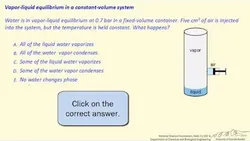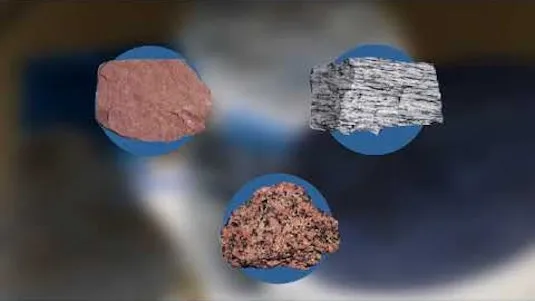
Thermodynamics: Interactive Screencasts 
This course provides interactive screencasts on thermodynamics topics such as adding air to a VLE system, adding components to a binary system in VLE, adding components with negligible vapor pressure to water, adding an ideal gas to an ideal gas, and adding octane to hexane in VLE. Through these interactive screencasts, students can gain a better understanding of thermodynamics concepts. ▼
ADVERTISEMENT
Course Feature
![]() Cost:
Cost:
Free
![]() Provider:
Provider:
Youtube
![]() Certificate:
Certificate:
Paid Certification
![]() Language:
Language:
English
![]() Start Date:
Start Date:
On-Demand
Course Overview
❗The content presented here is sourced directly from Youtube platform. For comprehensive course details, including enrollment information, simply click on the 'Go to class' link on our website.
Updated in [February 21st, 2023]
What does this course tell?
(Please note that the following overview content is from the original platform)
Add Air to VLE System (Interactive).
Add Component to Binary System in VLE (Interactive).
Add Component with Negligible Vapor Pressure to Water (Interactive).
Add Ideal Gas to an Ideal Gas (Interactive).
Add Octane to Hexane in VLE (Interactive).
Add One Component to System with Azeotrope (Interactive).
Add Water to Hexane at Constant Pressure (Interactive).
Adsorption on a Zeolite (Interactive).
Compare Gas Flow Through Expansion Valve and Turbine (Interactive).
Compare Work in Two Turbines (Interactive).
Constant-Volume Process on PT Diagram (Interactive).
Crankshaft (Interactive).
Decrease Temperature for VLE System (Interactive).
Entropy Change for Gases Expanding in a Vacuum (Interactive).
Entropy Change for Reversible and Irreversible Pathways (Interactive).
Entropy Change for Two Containers of Water (Interactive).
Entropy Change for Two Systems: Add Work and Heat (Interactive).
Flow Between Tanks Containing Water of Different Qualities (Interactive).
Flow into an Evacuated Container (Interactive).
Fugacity of Oxygen Dissolved in Water (Interactive).
How does salt affect water VLE? (Interactive).
Increase Pressure on Binary VLE System (Interactive).
Inject Air into Binary System in VLE (Interactive).
Isotherm on a PV Diagram for a Binary Mixture (Interactive).
Lever Rule (Interactive).
Mass Transfer Between Two Containers (Interactive).
Mix Saturated Steam and Nitrogen (Interactive).
Office Duster Flow Rate (Interactive).
Osmotic Pressure to Determine Molecular Weight (Interactive).
Partial Pressure Change with Temperature (Interactive).
Phase Diagram for Partially Miscible Liquids (Interactive).
Phases Present for Immiscible Liquids (Interactive).
Perturb Heterogeneous Equilibrium (Interactive).
Possible Phases for Immiscible Liquids (Interactive).
Raise Pressure for Air/Water Vapor Mixture (Interactive).
Remove Liquid from VLE System (Interactive).
Supercooled Liquid Goes to Equilibrium (Interactive).
Temperature of Room with Refrigerator Open (Interactive).
Two Partially Miscible Phases in Equilibrium (Interactive).
Vapor-Liquid Equilibrium and Fugacity (Interactive).
Which Curve is for an Irreversible Adiabatic Expansion? (Interactive).
Which Process Can Occur? (Interactive).
Which Reaction Reaches Equilibrium First? (Interactive).
We consider the value of this course from multiple aspects, and finally summarize it for you from three aspects: personal skills, career development, and further study:
(Kindly be aware that our content is optimized by AI tools while also undergoing moderation carefully from our editorial staff.)
1. You can gain a comprehensive understanding of thermodynamics by learning the interactive screencasts. Through the interactive screencasts, you can learn about the concepts of air and component addition to binary systems, ideal gas addition to an ideal gas, octane addition to hexane, one component addition to a system with an azeotrope, water addition to hexane at constant pressure, adsorption on a zeolite, gas flow through expansion valves and turbines, work in two turbines, constant-volume process on PT diagrams, crankshaft, decrease temperature for VLE systems, entropy change for gases expanding in a vacuum, entropy change for reversible and irreversible pathways, entropy change for two containers of water, entropy change for two systems with added work and heat, flow between tanks containing water of different qualities, flow into an evacuated container, fugacity of oxygen dissolved in water, how salt affects water VLE, increase pressure on binary VLE systems, inject air into binary systems in VLE, isotherm on a PV diagram for a binary mixture, lever rule, mass transfer between two containers, mix saturated steam and nitrogen, office duster flow rate, osmotic pressure to determine molecular weight, partial pressure change with temperature, phase diagram for partially miscible liquids, phases present for immiscible liquids, perturb heterogeneous equilibrium, possible phases for immiscible liquids, raise pressure for air/water vapor mixtures, remove liquid from VLE systems, supercooled liquid goes to equilibrium, temperature of room with refrigerator open, two partially miscible phases in equilibrium, vapor-liquid equilibrium and fugacity, which curve is for an irreversible adiabatic expansion, which process can occur, and which reaction reaches equilibrium first.
2. You can gain a better understanding of the application of thermodynamics in real-world scenarios by learning the interactive screencasts. Through the interactive screencasts, you can learn how to add air to VLE systems, add components to binary systems in VLE, add components with negligible vapor pressure to water, add ideal gas to an ideal gas, add octane to hexane in VLE, add one component to a system with an azeotrope, add water to hexane at constant pressure, adsorb on a zeolite, compare gas flow through expansion valves and turbines, compare work in two turbines, constant-volume process on PT diagrams, crankshaft, decrease temperature for VLE systems, entropy change for gases expanding in a vacuum, entropy change for reversible and irreversible pathways, entropy change for two containers of water, entropy change for two systems with added work and heat, flow between tanks containing water of different qualities, flow into an evacuated container, fugacity of oxygen dissolved in water, how salt affects water VLE, increase pressure on binary VLE systems, inject air into binary systems in VLE, isotherm on a PV diagram for a binary mixture, lever rule, mass transfer between two containers, mix saturated steam and nitrogen, office duster flow rate, osmotic pressure to determine molecular weight, partial pressure change with temperature, phase diagram for partially miscible liquids, phases present for immiscible liquids, perturb heterogeneous equilibrium, possible phases for immiscible liquids, raise pressure for air/water vapor mixtures, remove liquid from VLE systems, supercooled liquid goes to equilibrium, temperature of room with refrigerator open, two partially miscible phases in equilibrium, vapor-liquid equilibrium and fugacity, which curve is for an irreversible adiabatic expansion, which process can occur, and which reaction reaches equilibrium first.
3. You can gain a better understanding of the mathematical and graphical representations of thermodynamics by learning the interactive screencasts. Through the interactive screencasts, you can learn how to use graphs and equations to represent the concepts of air and component addition to binary systems, ideal gas addition to an ideal gas, octane addition to hexane, one component addition to a system with an azeotrope, water addition to hexane at constant pressure, adsorption on a zeolite, gas flow through expansion valves and turbines, work in two turbines, constant-volume process on PT diagrams, crankshaft, decrease temperature for VLE systems, entropy change for gases expanding in a vacuum, entropy change for reversible and irreversible pathways, entropy change for two containers of water, entropy change for two systems with added work and heat, flow between tanks containing water of different qualities, flow into an evacuated container, fugacity of oxygen dissolved in water, how salt affects water VLE, increase pressure on binary VLE systems, inject air into binary systems in VLE, isotherm on a PV diagram for a binary mixture, lever rule, mass transfer between two containers, mix saturated steam and nitrogen, office duster flow rate, osmotic pressure to determine molecular weight, partial pressure change with temperature, phase diagram for partially miscible liquids, phases present for immiscible liquids, perturb heterogeneous equilibrium, possible phases for immiscible liquids, raise pressure for air/water vapor mixtures, remove liquid from VLE systems, supercooled liquid goes to equilibrium, temperature of room with refrigerator open, two partially miscible phases in equilibrium, vapor-liquid equilibrium and fugacity, which curve is for an irreversible adiabatic expansion, which process can occur, and which reaction reaches equilibrium first.
4. You can gain a better understanding of the practical implications of thermodynamics by learning the interactive screencasts. Through the interactive screencasts, you can learn how to apply thermodynamics to real-world scenarios such as air and component addition to binary systems, ideal gas addition to an ideal gas, octane addition to hexane, one component addition to a system with an azeotrope, water addition to hexane at constant pressure, adsorption on a zeolite, gas flow through expansion valves and turbines, work in two turbines, constant-volume process on PT diagrams, crankshaft, decrease temperature for VLE systems, entropy change for gases expanding in a vacuum, entropy change for reversible and irreversible pathways, entropy change for two containers of water, entropy change for two systems with added work and heat, flow between tanks containing water of different qualities, flow into an evacuated container, fugacity of oxygen dissolved in water, how salt affects water VLE, increase pressure on binary VLE systems, inject air into binary systems in VLE, isotherm on a PV diagram for a binary mixture, lever rule, mass transfer between two containers, mix saturated steam and nitrogen, office duster flow rate, osmotic pressure to determine molecular weight, partial pressure change with temperature, phase diagram for partially miscible liquids, phases present for immiscible liquids, perturb heterogeneous equilibrium, possible phases for immiscible liquids, raise pressure for air/water vapor mixtures, remove liquid from VLE systems, supercooled liquid goes to equilibrium, temperature of room with refrigerator open, two partially miscible phases in equilibrium, vapor-liquid equilibrium and fugacity, which curve is for an irreversible adiabatic expansion, which process can occur, and which reaction reaches equilibrium first.
5. You can gain a better understanding of the theoretical foundations of thermodynamics by learning the interactive screencasts. Through the interactive screencasts, you can learn about the fundamental principles of thermodynamics such as air and component addition to binary systems, ideal gas addition to an ideal gas, octane addition to hexane, one component addition to a system with an azeotrope, water addition to hexane at constant pressure, adsorption on a zeolite, gas flow through expansion valves and turbines, work in two turbines, constant-volume process on PT diagrams, crankshaft, decrease temperature for VLE systems, entropy change for gases expanding in a vacuum, entropy change for reversible and irreversible pathways, entropy change for two containers of water, entropy change for two systems with added work and heat, flow between tanks containing water of different qualities, flow into an evacuated container, fugacity of oxygen dissolved in water, how salt affects water VLE, increase pressure on binary VLE systems, inject air into binary systems in VLE, isotherm on a PV diagram for a binary mixture, lever rule, mass transfer between two containers, mix saturated steam and nitrogen, office duster flow rate, osmotic pressure to determine molecular weight, partial pressure change with temperature, phase diagram for partially miscible liquids, phases present for immiscible liquids, perturb heterogeneous equilibrium, possible phases for immiscible liquids, raise pressure for air/water vapor mixtures, remove liquid from VLE systems, supercooled liquid goes to equilibrium, temperature of room with refrigerator open, two partially miscible phases in equilibrium, vapor-liquid equilibrium and fugacity, which curve is for an irreversible adiabatic expansion, which process can occur, and which reaction reaches equilibrium first.
[Applications]
Completing the Thermodynamics: Interactive Screencasts course provides learners with a comprehensive understanding of thermodynamics and its application. Learners can apply the knowledge gained from this course to analyze and solve problems related to vapor-liquid equilibrium, phase diagrams, entropy change, and more. They can also use the interactive screencasts to gain a better understanding of the concepts and to practice problem-solving. Additionally, learners can use the course to gain a better understanding of the thermodynamic properties of different substances and how they interact with each other.
[Career Paths]
Three potential career paths that could be recommended to learners of this course are:
1. Thermal Engineer: Thermal engineers are responsible for designing, developing, and testing thermal systems and components. They use thermodynamics principles to analyze and optimize the performance of these systems. They also use their knowledge of thermodynamics to troubleshoot and solve problems related to thermal systems.
2. Process Engineer: Process engineers use thermodynamics principles to design, develop, and optimize processes for the production of goods and services. They analyze the thermodynamic properties of materials and processes to ensure that they are efficient and cost-effective. Process engineers are also responsible for troubleshooting and solving problems related to processes.
3. Energy Engineer: Energy engineers use thermodynamics principles to design, develop, and optimize energy systems. They analyze the thermodynamic properties of energy systems to ensure that they are efficient and cost-effective. Energy engineers are also responsible for troubleshooting and solving problems related to energy systems.
Course Provider

Provider Youtube's Stats at AZClass
Over 100+ Best Educational YouTube Channels in 2023.
Best educational YouTube channels for college students, including Crash Course, Khan Academy, etc.
AZ Class hope that this free Youtube course can help your Thermodynamics skills no matter in career or in further education. Even if you are only slightly interested, you can take Thermodynamics: Interactive Screencasts course with confidence!
Discussion and Reviews
0.0 (Based on 0 reviews)
Explore Similar Online Courses

Make a Professional Business Website with This Free Theme

Web Design for Beginners

Python for Informatics: Exploring Information

Social Network Analysis

Introduction to Systematic Review and Meta-Analysis

The Analytics Edge

DCO042 - Python For Informatics

Causal Diagrams: Draw Your Assumptions Before Your Conclusions

Whole genome sequencing of bacterial genomes - tools and applications

Viscous Fluid Flow

Metamorphic Petrology & Thermodynamics


Start your review of Thermodynamics: Interactive Screencasts